A Royal Stitch-Up
| May 23, 2023A powerhouse of world-class tailoring, where the iconic uniforms for Great Britain’s most recognizable soldiers are created
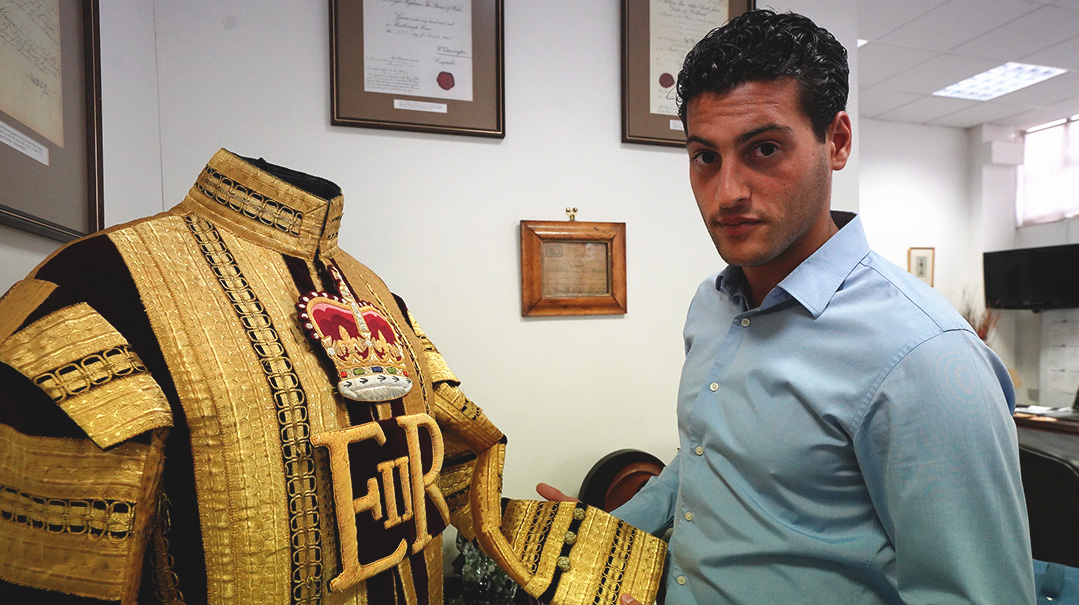
Photos:Mendel Photography
The rowdy protestors chanting “Not my king!” near the route of the Coronation procession, corralled into a side street by police, needn’t have bothered. They were vastly outnumbered, not only by the poncho-clad throngs lining the 1.4-mile route under a steady British drizzle hoping to catch a glimpse of the golden carriage and its royal occupants, but also by the endless formations of the King’s Grenadier and Coldstream Guards, instantly recognizable in their tall furry hats and bright red tunics with gleaming buttons. Their regimental marching band, who play at Changing of the Guard, state visits, and other events, belted out tune after tune with rhythmic precision.
If anyone shepped nachas from the spectacle, it’s got to be Nathan Kashket and his father, Russell. Their firm, Kashket and Partners, designs and manufactures the uniforms that serve as emblems of London and Great Britain, from the Beefeaters at the Tower of London to the scarlet tunics of the guards strutting up and down outside Buckingham Palace. The Kashket family’s sewing needles are the instruments of choice to design, stitch, and mend for the royal household’s best-dressed staff.
A proudly Jewish family arriving as immigrants around the turn of the century, the Kashkets retained their distinctly Jewish last name (Yiddish, meaning a kind of hat) at a time when many others anglicized their identity in an effort to blend in and perhaps achieve some degree of upward social mobility. Now the Kashket name has become synonymous with the highest-quality military and ceremonial wear.
Soon after Queen Elizabeth II passed away last September at the ripe old age of 96, the coronation of her eldest son and successor Charles went into planning. At 74, he was the longest-serving heir-apparent, having waited in the line of succession for 70 years.
Anticipating the country’s first coronation in seven decades, an event whose 2,000 guests would include world leaders, dignitaries, diplomats, and celebrities, the world watched and eargerly waited. What would Buckingham Palace — undisputed international headquarters of pomp, pageantry, and precision — deliver?
What emerged was an awe-inspiring multistage procession of nearly 4,000 service personnel who fronted, backed, and flanked the 260-year-old Golden State Coach pulled by eight white steeds as it trundled its way down the Mall back to the Palace ahead of the iconic balcony appearance.
Each section taking a page from an age-old military history book, they appeared magnificently attired in gleaming, traditional uniforms, some riding on horseback while playing an instrument or beating a drum in one of twenty different bands. This military ceremonial operation, the largest of its kind since Queen Elizabeth’s 1953 coronation, reverently and majestically conveyed their newly crowned majesties back home.
The change in sovereign has left Nathan Kashket — who at 25 now oversees the company’s operations — with little time to catch his breath. Because coming fast on the heels of the Coronation is next month’s annual display of pageantry, Trooping of the Colour, held each summer to mark the British monarch’s birthday. Over 1,400 soldiers, 200 horses, and 400 musicians come together in precision and fanfare — and Nathan’s company is working full pelt to make sure it’s all ready to roll.
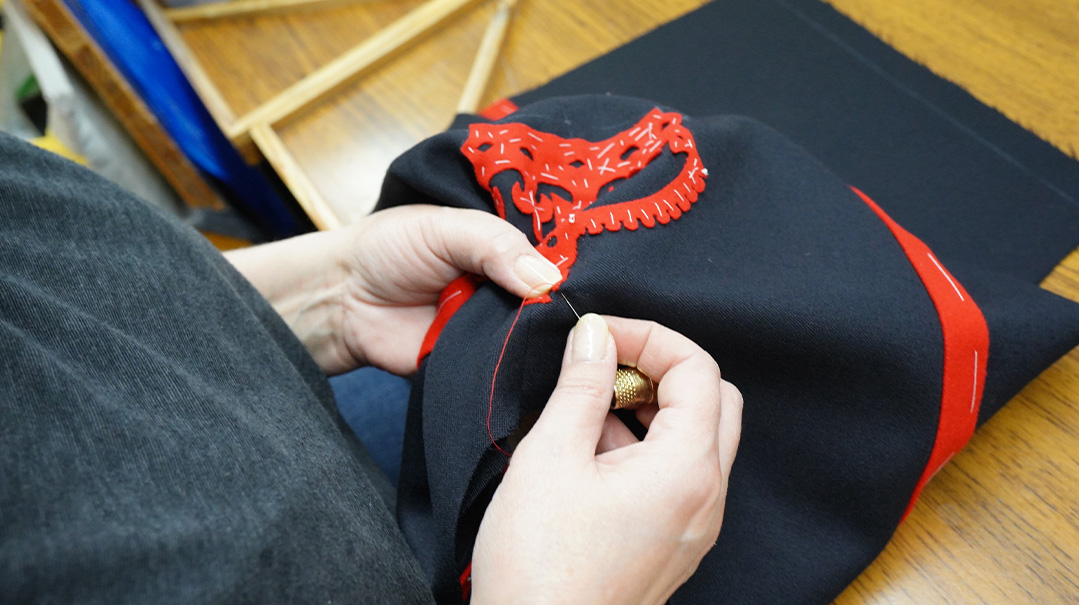
All the King’s Men
The nondescript exterior of Kashket and Partners belies the prominent activity it houses. It’s located on a dusty London industrial estate opposite a waste disposal facility and a flooring warehouse. Dated railings and a faded sign complete the scene. But step inside, and you enter a large room housing a staff of around 40 expert tailors who hand-produce premium-quality ceremonial uniforms for the royal family’s guards.
The men and women work industriously, with a confidence born of years of experience. Some feed fabric through sewing machines, others stand at wide work tables surrounded by piles of fabric, chalking, cutting, and stitching, tape measures draped around their necks. All along the wall are hooks on which hang patterns of all shapes and sizes, the flat pieces of material used as the blueprint for garments. Folded neatly on tables are clothes in various stages of production, seams on show and loose threads sticking out. On the back wall are an array of high-pressure irons and presses. It’s like the Lower East Side sweatshops of yore — sans the subpar working conditions.
Coat rails line the perimeter of the room, displaying rows of exquisitely tailored garments awaiting their new owners. Each made-to-measure garment has a tag pinned on detailing the name and service number of the military serviceman or woman it was made for — and an exhaustive list of measurements.
“They make it look easy,” says Nathan of his staff, “but they’re all masters of their craft.”
Nathan stops at a table and picks up a lapel edged with a neat row of gleaming gold beads. “See these beads?” he asks, then turns the segment over to reveal a neat row of stitches sewn with military precision down the full length of the garment. “The beads don’t get delivered to us looking like this,” he continues. “Each one is individually attached by hand.”
The beads — along with the scores of different buttons and other accessories — are manufactured by their sister company, Firmin House. Nathan’s father, Russell, created an internal supply chain of sorts. Most of their materials are sourced in-house, which helps keep costs down, profits up, and most importantly ensures a reliable supply.
Nathan moves on and picks up part of a partly finished short jacket with an intricate gold rope design, sewn to perfection. This is the front of a King’s Troop Sergeant Major uniform that’s taken around 30 hours of hand stitching to create. With its matching shoulder piece and a chest full of medals thrown in for good measure, it’s sure to impress.
An elegant collar is next, featuring a thick multi-layered gold braid overlaid several times to produce a stiff piece that also contains 2% gold. Once complete, it will be part of a Drum Major’s State Coat. On the next table a worker is attaching a red strip to the length of a trouser leg, recognizable as the uniform of Buckingham Palace’s Kings Guards.
“We make trousers, pantaloons, short coats, great coats, state coats — you name it,” says Nathan, hinting at the sheer magnitude of their operation. “We supply over 48,000 products directly to the armed forces, including metal works, such as all the different badges and buttons.”
All the high-end handmade items are made here in their London facility, but they also have operations in Leeds, Birmingham, Coventry, and Surrey.
Despite the pressure he is currently under, Nathan is quick to highlight his staff’s positive attitude. “With so many logistics to see to — numbers, deadlines, meetings — my job is so easy when I have such a fabulous team.”
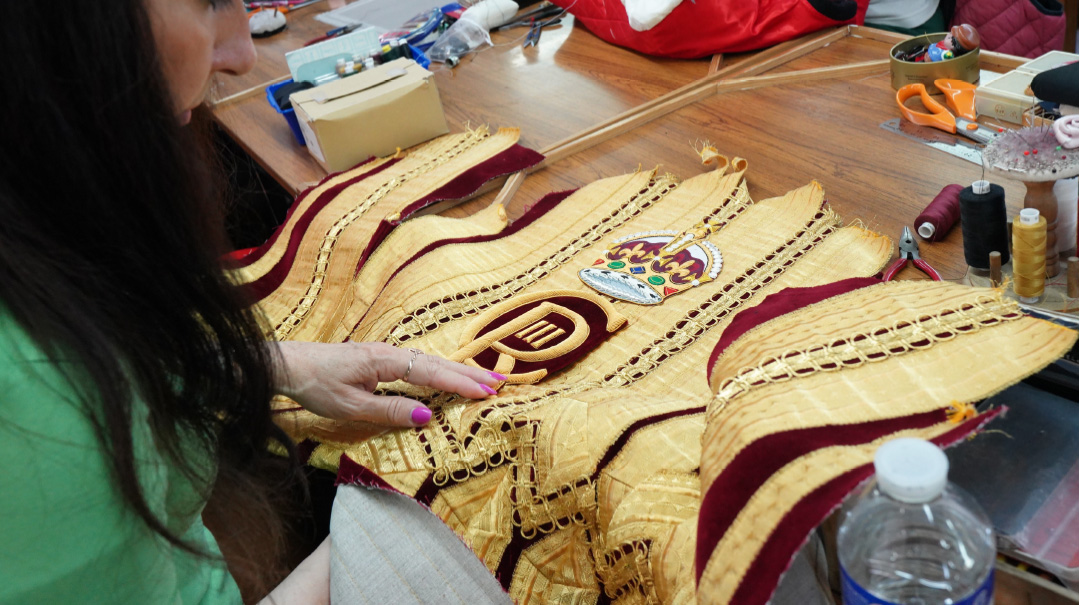
Royal Cypher
A central focus for Nathan’s select team leading up to the Coronation was His Majesty’s unique monogram — known as the cypher — as well as the newly designed crown. Royal cyphers appear on everything from state documents to letterboxes and postage stamps. Crucially for the Kashkets, they are also sewn onto the front of some of the most visible ceremonial uniforms, and to multitudes of uniforms of British Army and Royal Air Force personnel taking part in the Coronation.
The late queen’s cypher had the letters E and R side by side with the Roman numeral II in between, signifying Elizabeth Regina the Second. “When Her Majesty the Queen died,” explains Nathan, “we of course anticipated the state funeral, followed by the change in monarchy, and crucially for us, the Coronation and the king’s new cypher.”
Kashkets received word last November that the new king’s cypher and crown were nearing completion. The cypher consists of an interlocking C and R, with the Roman numeral III inside the R — signifying Charles Royal the Third. Nathan proudly shows takes us to a table where a pile of new cyphers and crowns lie in a tray, exquisite pieces of hand-stitched craftsmanship.
Although the Kashkets have a large number of clients (they currently design and produce garments for nine different monarchs and have customers from 45 countries), the contractors representing the royal family made it clear that, with the coronation date set, they expected other orders be put on hold to ensure the success of the royal events.
“They are our bread and butter,” says Nathan, “and justifiably, they wanted us to fully focus on the task.”
After successfully filling the order for the Coronation, Kashket and Partners are now focused on Trooping the Colour. The new cyphers will be affixed to the uniforms of the most prominent royal guards who will parade in front of the king and queen next month.
With so many different regiments and units, there’s a never-ending stream of work for the Kashkets to busy themselves with. And to ensure that serving personnel look their very best, their own tailors work in-house at each of the 96 army barracks up and down the country, ensuring that every uniform sits well and is fitted with the correct buttons, badges, and crests.
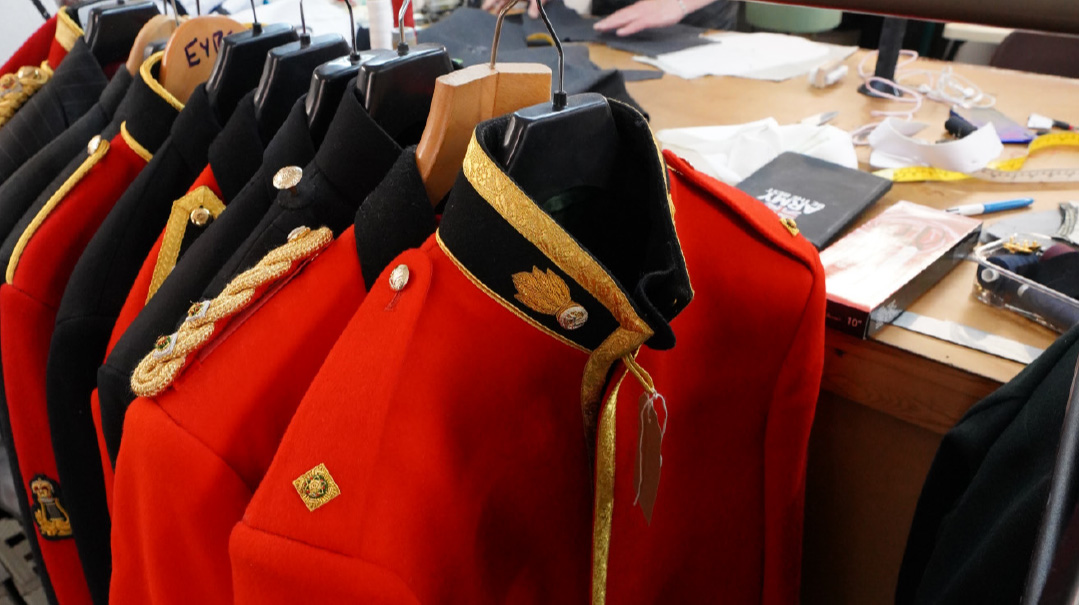
Dressed to Impress
Providing sartorial services to the military is a common thread for generations of Kashkets. Nathan’s great-great-grandfather used to supply hats to the czar, hence the family name. His son Alfred, Nathan’s great-grandfather, arrived in the UK along with thousands of fellow Jewish refugees seeking a better life, and settled in the great melting pot that was the East End of London. Like many of his ilk, he was a tailor, and he found employment with the largest military supplier at the time, Silverstones.
Nathan’s Uncle Marlon, sitting at a nearby sewing machine, lays down his tools to continue the tale. “They were trying to get the iconic red tunic made, but somehow they couldn’t manage to get it right,” he relates. “So they gave Alfred the job, and he nailed it first time.”
Then, when the Silverstones firm went under, the Kashkets moved in to fill the void — and the business was born. Today Kashkets and their sister company Firmin House are the sole supplier of uniforms to all branches of the UK’s defense forces: the Army, Royal Navy, Royal Air Force, and Royal Marines. Firmins also manufacture the helmets worn by the Household Cavalry.
Marlon Kashket is especially proud of the fact that until today, the manufacture of the ceremonial uniforms at their London facility is still done by hand — bona fide tailoring. “Not a compu’er to be seen!” declares Marlon in the strongest Cockney accent I’ve ever come across.
Nathan entered the business at 16, straight out of King Solomon, an Orthodox secondary school in the East London borough of Redbridge. His parents were keen that their five sons should receive a traditional Jewish education. Nathan says that although he perhaps enjoyed himself too much at school, he was appreciative of the opportunity to ground himself more Jewishly.
His father, current CEO Russell Kashket, put him to work on an ironing press working eight hours a day on his feet, training him in to appreciate a hard day’s graft.
“At the time,” Nathan recalls, “I thought we were just producing suits for Marks and Spencer’s Best of British range. I didn’t realize that the lion’s share of our business was supplying the UK’s defense forces.”
Nearby, iron in hand, is Albert, head of trouser production. At 35 years in the business, he is Kashket’s longest-serving employee. He remembers when Nathan started, wide-eyed at the sheer scope of the operation.
“I was the one encouraging you back then, and now you’re in charge!” says Albert with a chuckle.
His leadership role notwithstanding, Nathan places emphasis on treating all the company’s employees with utmost respect, a trait he says he learned from his father.
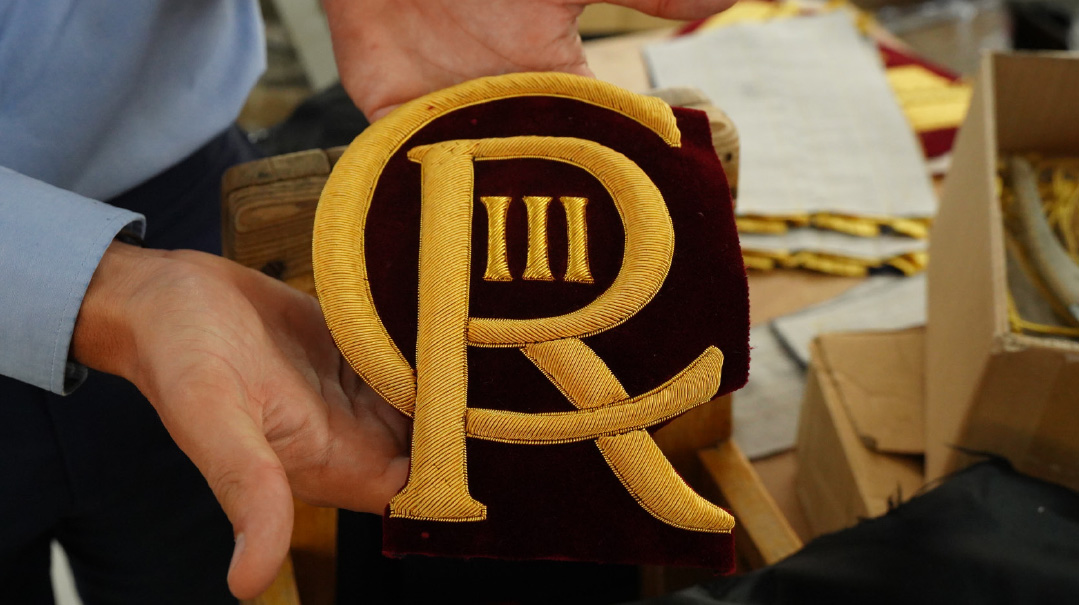
Royal Connections
Although the royal household are their most prominent client, Nathan is tight-lipped about the family’s interactions with royalty. But there are hints to the latter’s esteem for the Kashkets’ longstanding service: on the wall hang two MBE (Member of the British Empire) awards, prestigious medals given by the royal family to civilians for their contributions to public life. Nathan’s great-grandfather and grandfather both received MBEs in recognition of their work.
More recently, Nathan’s father Russell played a key role in the wedding regalia of current heir-apparent Prince William and his wife Catherine. Russell designed the page boys’ outfits, and he and his father were invited to attend. After the wedding, they received a handwritten letter from Catherine (known as Kate), thanking them for their hard work.
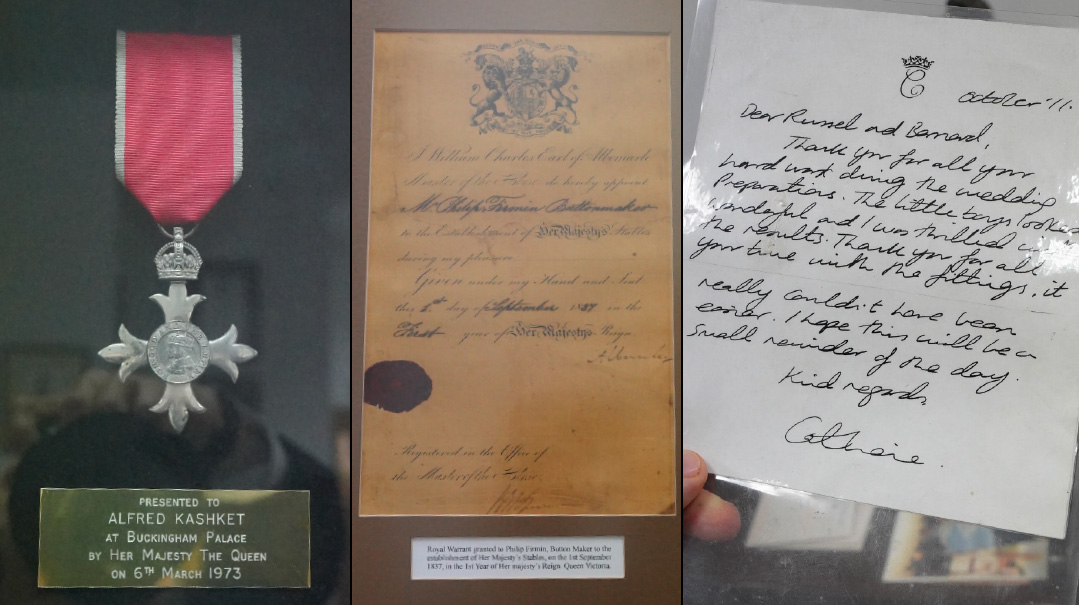
Three Kings
Although the arrest of 52 anti-monarchy protestors during the Coronation may have caught the media’s attention, one display of the British monarchy’s firmly established chain of succession was impossible to miss during the service: William, heir to the throne, kneeled before his father the king, declaring his allegiance and loyalty on behalf of all members of the royal family.
Looking on was William’s nine-year-old son George, who was tasked with helping carry his grandfather’s robes as he made his way into London’s Westminster Abbey for the official ceremony, the first time in modern royal history that a future monarch was officially involved in such a service.
With the chain of royal succession a well-established fact, the Kashket family know that their trusted service and sartorial talent will continue to be called upon for many years to come. Nathan is pensive for a moment.
“It’s not just about supplying the armed forces,” he says. “As sovereign, the king is head of the armed forces, so in effect we’re working for him, and that’s the highest privilege.”
(Originally featured in Mishpacha, Issue 962)
Oops! We could not locate your form.







